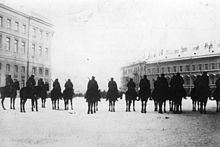Petersburg Bloody Sunday
The Petersburg Bloody Sunday (also Bloody Sunday , Red or Black Sunday was) of 1905, an event in the history of the Russian Empire and part of the 1905 Russian Revolution .
Bloody Sunday
In the first days of January 1905, a general strike first hit the Putilov works and soon afterwards the shipyards, factories and weaving mills. On Sunday January 9th, Jul. / January 22, 1905 greg. Tens of thousands of workers, led by the Orthodox priest Father Georgi Gapon , went on a star march from the suburbs of Saint Petersburg to the Winter Palace , the residence of the Tsar , with the intention of peacefully demonstrating for more humane operating conditions, agricultural reforms, the abolition of censorship and religious tolerance . The demonstrators also called for the creation of a representative body . However , the demonstrators did not advance until Tsar Nicholas II . Even in front of the Narva Gate they were stopped by soldiers who shot at the crowd. In the afternoon there were clashes around the Winter Palace, in which the army again shot at the demonstrators. The information and estimates of the victims among the demonstrators vary. The writer Alexander Issajewitsch Solzhenitsyn and, most recently, the historian Kevin O'Connor have contradicted information about 1,000 deaths . While Solzhenitsyn in Archipelago Gulag , Volume 3, speaks of 400 dead, Kevin O'Connor assumes 130 dead.
Revolutionary unrest ensued
As a result, the Russian people rose against the authorities : strikes , revolutionary uprisings, mutiny , and murders of landowners and industrialists were the order of the day. A violent wave of protests against the tsar's policies spread. A general strike by the socialist organized workers paralyzed public life in order to force the tsar to make some concessions. Under public pressure, this brought out the October Manifesto , which proclaimed fundamental rights and a legislative representative body, the Duma , on the basis of universal suffrage. There was no real improvement, however, because the tsar immediately dissolved parliament. Political tensions continued.
The posed photo from 1925
Although pictures of the streets and barricades were taken on site on January 22, 1905, none of the pictures achieved the popularity and dissemination of the picture, which shows a crowd of people fleeing from a row of soldiers in snow-covered St. Petersburg. The recording unfolds an impressive intensity:
"The position of the soldiers and the masses in the snow, the sharp contrast between black and white and the cut of the diagonals, all of this contributed to the success of the picture, in which one believes to recognize the Soviet cinema style of the twenties."
The photo probably shows a scene from the film Devjatoe Janvarja (German January 9th ) or, among other things, the title Krovavoe voskresen'je (German Blood Sunday ) by Vyacheslav Wiskowski , which he shot in 1925 with some prominent actors. In addition to Yevgeny Boronihin in the role of the priest Gapon, Alexander Edwakow plays Nikolaus II. The photo would therefore have been taken during the shooting; Whether this is a photogram copied from the film or a still photo can no longer be conclusively clarified today.
The photo did not appear in newspapers and magazines until the late 1920s. It was distributed by the TASS between 1927 and 1930 and issued as an authentic 1905 recording. It found its way into almost all Russian history books as a special, impressive picture of the events. Other works also published the picture, such as the history of photography published in 1977 under the title Les premiers reporters photographes 1848–1914 (German The first photo reporters 1848–1914 ).
Individual evidence
- ↑ Kevin O'Connor: The History of the Baltic States. Greenwood Publishing Group, Westport 2003, ISBN 0-313-32355-0 , p. 69.
- ↑ Alain Jaubert: Photos that lie. Politics with fake pictures. Athenaeum, Frankfurt am Main 1989, ISBN 3-610-08523-1 , p. 43.
- ↑ Alain Jaubert: Photos that lie. Politics with fake pictures. Athenaeum, Frankfurt am Main 1989, ISBN 3-610-08523-1 , pp. 42-43.


